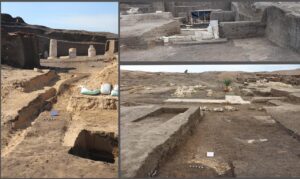
The Egyptian archaeological mission of the Supreme Council of Antiquities, discovered the largest astronomical observatory building from the sixth century BC while excavating at the Temple of Buto in Tell al-Faraeen, at Kafr el-Sheikh Governorate.
The observatory is built of mud bricks and was used to monitor and record astronomical observations and the movement of the sun and stars in the temple located in the city.

The Secretary-General of the Supreme Council of Antiquities Mohamed Ismail Khaled hailed the team’s efforts and this major discovery.
This finding displays how skilled ancient Egyptians were in astronomy, he said, revealing how they determined their solar calendar and the dates of religious and official rituals such as the coronation of kings and the agricultural year, in addition to shedding light on ancient astronomical techniques.

The head of the Egyptian Antiquities Sector at the Supreme Council of Antiquities, Ayman Ashmawy, said that the astronomical observatory building covers approximately 850 square meters.
It consists of an entrance facing east where the sun rises, he added, with a central columned hall open in the shape of the letter “L” preceded by a huge, high wall of mud bricks with an inward slope, resembling the style of the Egyptian edifice known in temple entrances.
Ashmawy said that the mission also found five mud brick rooms likely used to store tools, four small mud brick rooms, and a small stone room representing the observatory tower.
The mission also found a relatively large hall with three walls covered with yellow tiles decorated with some scenes and the remains of a blue drawing of a ritual boat with eight compartments.
From the back are the remains of two oars, and from the front are the inscription depicting the head of the falcon Horus and the Eye of Udjat, which embodies the systems of the universe and is linked to the sun, the moon, the god Horus, and the goddess Udjat, the most important gods of Buto.
The Director General of Kafr el-Sheikh Antiquities Area and head of the mission Hossam Ghoneim, said that some statues were also found inside the observatory building.
These include a gray granite statue from the “Wah-Ib-Ra” era of the Twenty-Sixth Dynasty, of the priest Psamtik-Semn carrying a statue of the god Osiris and the title of “Royal Seal Bearer” written on it.
The Merkhet measuring tool, was also found alongside other measuring tools.




